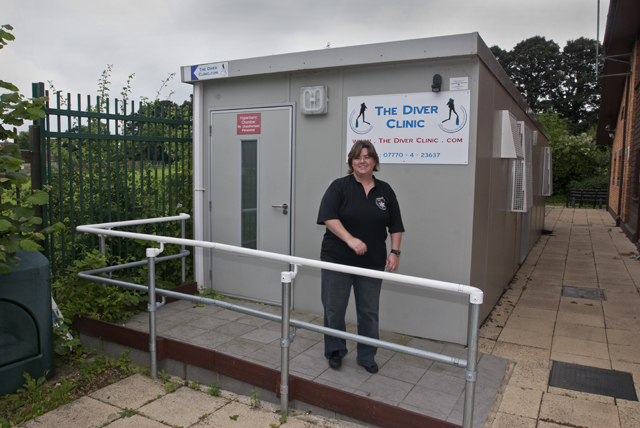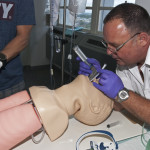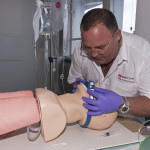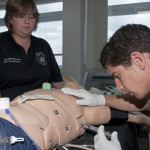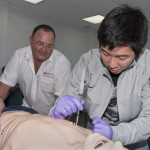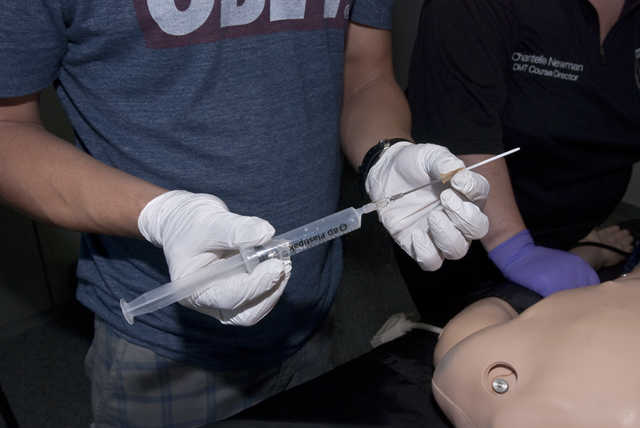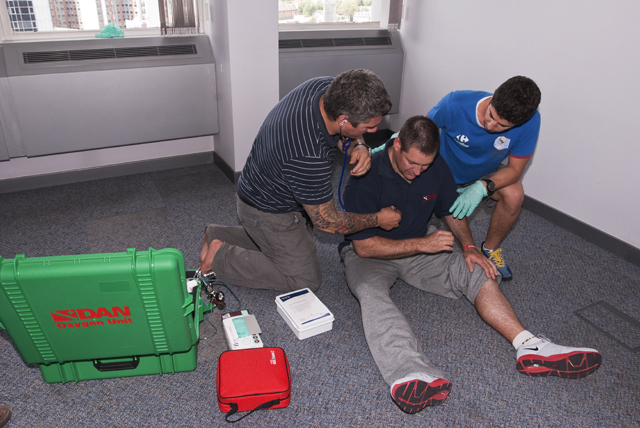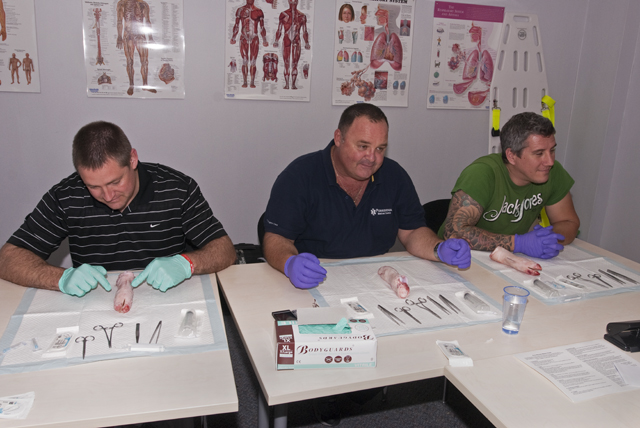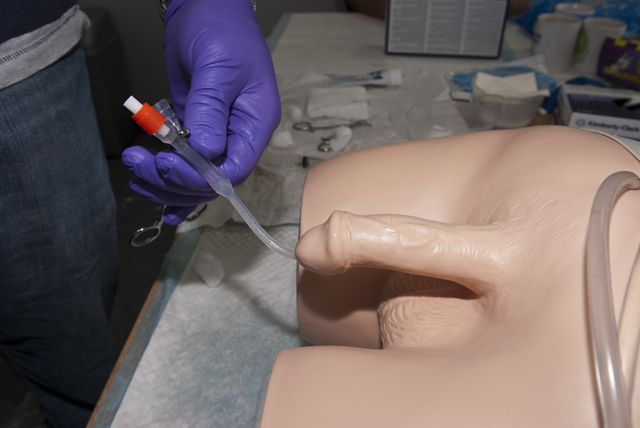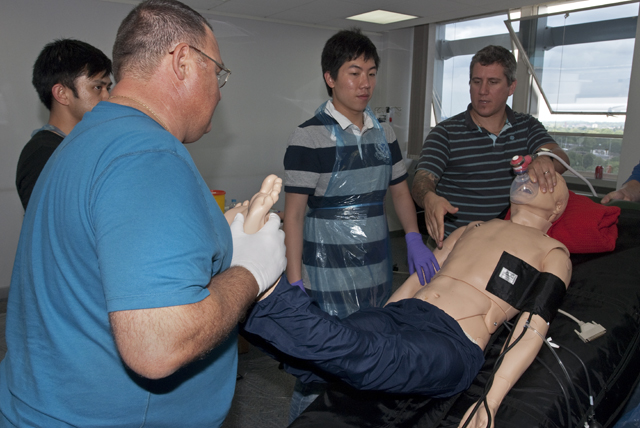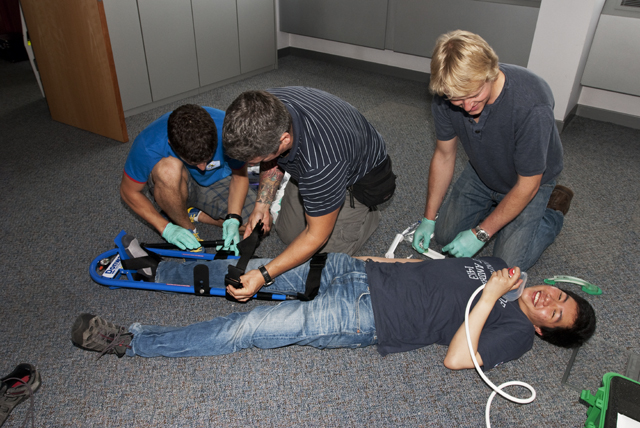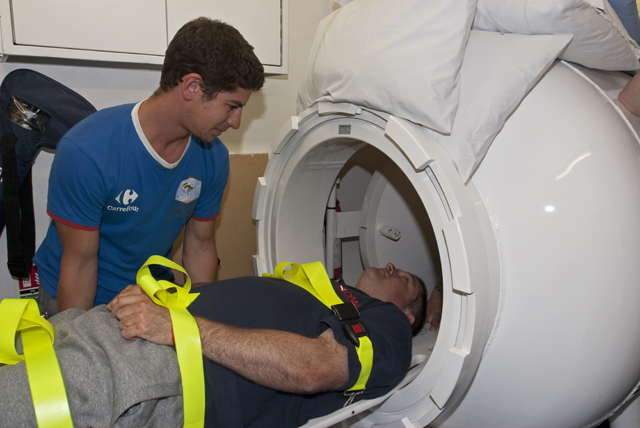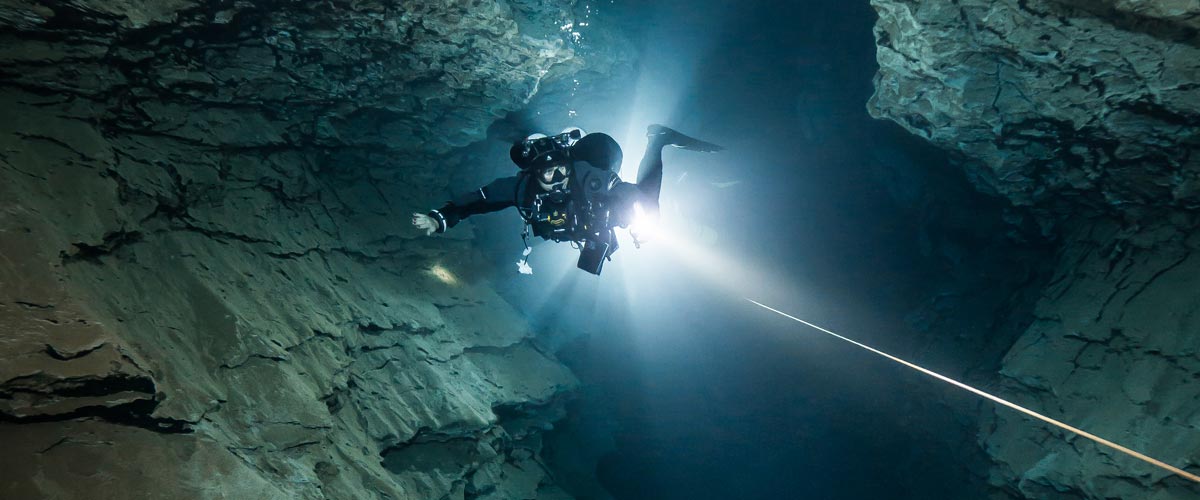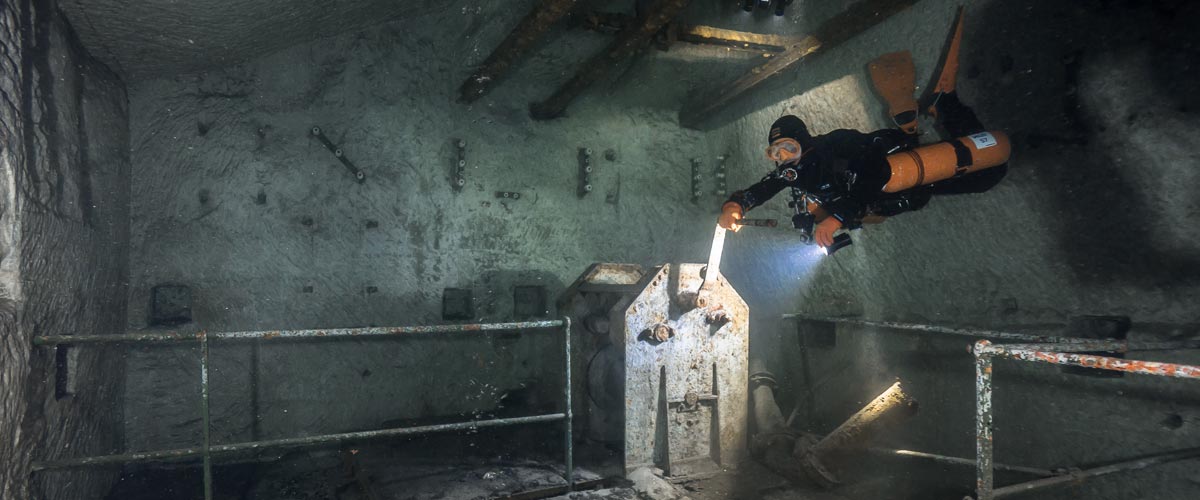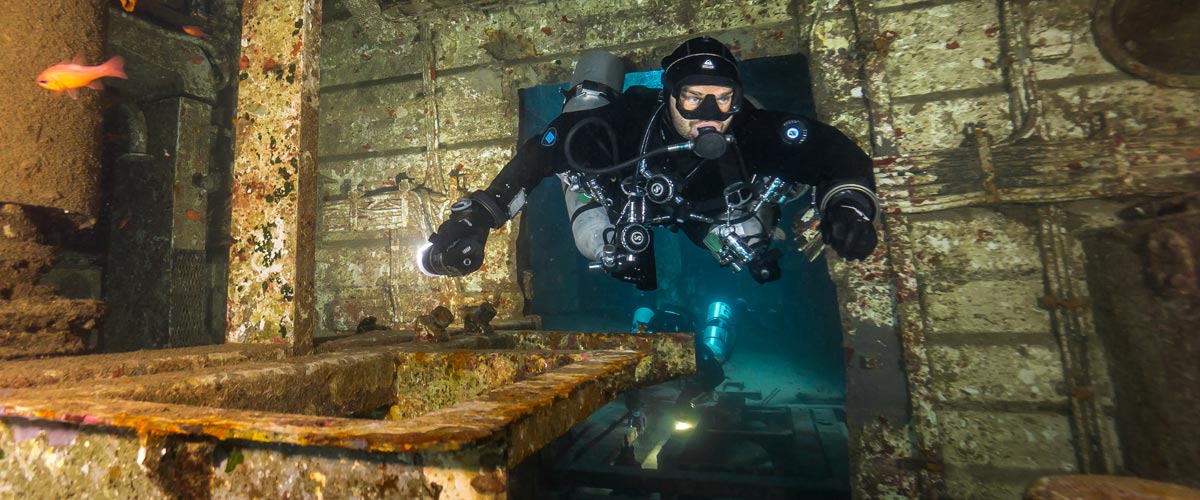Dive Training Blogs
Further into First Aid: DAN’s Diver Medic Technician Course
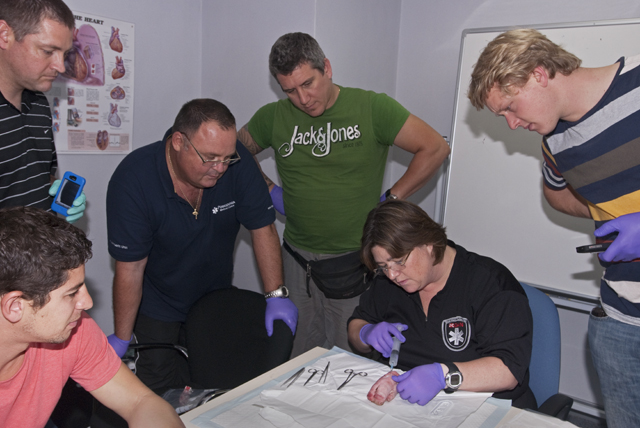
Let’s face the facts, diving accidents do happen. Thankfully not too often, but as an active scuba diver the law of probability states that sooner or later I will encounter some kind of first aid emergency. With this in mind I would hate to be unprepared or unable to help someone in their moment of need. So when I saw the advert on DAN Europe’s website promoting the diver medic technician (DMT) course run by Code Blue Education, I thought this was the perfect time for a refresher on the latest medical techniques and procedures.
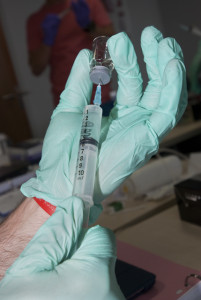 As well as covering the basic ABC’s the 2-week (80 hour) course entered into the realms of suturing, IV cannulation, catheterisation and dealing with a real life pneumothorax. I was really looking forward to the suturing session but the thought of catheterising a patient didn’t really fill me with inspiration. In fact I went weak at the knees just thinking about the procedure.
As well as covering the basic ABC’s the 2-week (80 hour) course entered into the realms of suturing, IV cannulation, catheterisation and dealing with a real life pneumothorax. I was really looking forward to the suturing session but the thought of catheterising a patient didn’t really fill me with inspiration. In fact I went weak at the knees just thinking about the procedure.
My last dabble with any form of medical training was a St John’s Ambulance first aid at work course several years ago. I was worried that my level of knowledge would be way below the required standard, but Chantelle Taylor-Newman, Director of Code Blue Education, reassured me that my background would be fine. I didn’t need to bring along any materials as everything from tea, coffee, soft drinks and chocolate muffins to all the course notes and even my own personal stethoscope would be included. I was already starting to get delusions (but then again, Doctor Philpott did have a certain ring to it!).
Chantelle said the DMT course is aimed at commercial and recreational divers. It’s actually an offshore requirement to have one DMT in each commercial diving team. Chantelle, who is also a certified PADI Divemaster, said “The DMT course is designed for commercial divers, but these days there seems to be more accidents in recreational diving, so I feel that it should be taught to all recreational divers as well.”
Code Blue Education is based in Brentford, London. They offer the full range of DAN courses up to Instructor level. The DAN/IMCA (International Marine Contractors Association) accredited DMT course is a new addition to their medical training portfolio. Chantelle said “We are looking at running the course every 2-3 months.” The content is currently around 40% theory and 60% practical work. There is a mid-week multiple choice exam followed by a final written and practical exam watched over by a practising medical professional.
Chantelle gave me some website links for pre-course reading, so when I turned up on Monday morning, I was raring to go. Even having to give a personal introduction in front of the group couldn’t dampen my enthusiasm. There was a good mix of people from different countries and job backgrounds. Andrea had just completed a commercial job looking for dead bodies on the Concordia cruise liner in Italy, and Oliver had been welding pipe work inside a sewage tank somewhere in Oz. Jason was studying economics in Scotland and Chris was working for the forestry commission in the home counties. The white collar workers were represented by Morne from DAN South Africa and Clive who owned 2 decompression chambers in Cyprus.
The first two days mainly consisted of theory focusing on physiology and basic first aid principles. Chantelle emphasised that hygiene was extremely important by saying “you can find faecal matter just about everywhere” (that’s such a nice thought!). Guest speaker Cary Marcelo, a care procedures and resuscitation Instructor working at Harley Street, went through the signs, symptoms and treatment for patients suffering from a variety of injuries. We had quite a few acronyms to remember. ABCDE and SAMPLE were the most widely used. Cary’s catchphrase was “Always treat what kills first.” During the practical sessions everybody had to wear gloves and use the oral nasal masks. I never realised how easy it was to use an AED (automated external defibrillator) – the unit basically talked me through the whole procedure. We also went through how to check blood pressure using a sphygmomanometer and a stethoscope.
Police diver Steve McKenna turned up mid-week to go through wounds, bleeding and fractures. Steve has worked with the marine unit for the past 14 years and gets called out on jobs anywhere in London. He had some very interesting (and gory) stories about past investigations. I can still visualise the picture showing a severed penis! Steve’s catchphrase was “We are going to lose people.” Steve explained that even with first aid treatment some people will die; in fact, the actual quoted figure is a 5% survival rate if an accident happens out on the street.
The day wouldn’t be complete without a few new acronyms to memorise. This time SAFE and RICE seemed to be the favourites. By far the best product Steve showed us was Celox. The haemostatic granules were developed for military use to stop severe bleeding. They are now being used by civilian paramedics. DAN even sells the packs on their website. The practical session using spinal boards, scoop stretchers and cervical collars gave everybody a chance to stretch their legs. I soon realised that trying to manoeuvre a stretcher and patient up and over objects and around tight corners is not an easy task.
To finish off the week we had a theory day on diving physics and diving related injuries. I already knew most of the information from my PADI Divemaster days so this was really just a refresher. Some of the pictures of skin and facial barotraumas (suit and mask squeeze) looked horrendous, but Chantelle reassured us that the injuries had healed up without any permanent injury.
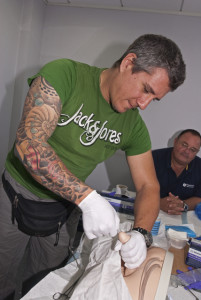
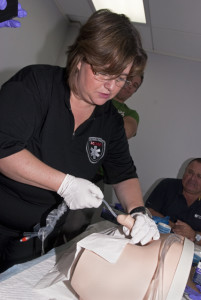 The second week involved more complex procedures starting with IV cannulation. I am not a fan of needles so this was quite an interesting session. We all got to practise on the plastic/rubber training arms that were filled with fake blood. Even I managed to get the procedure right after a few tries. Catheterisation had everybody grimacing apart from Chantelle who seemed to be smiling as she performed the delicate demonstration. Watching someone put a 30cm long catheter inside a penis brought tears to my eyes (it wasn’t a real penis I might add. We used a training manikin). This is one procedure I would not want to do in real life. Morne, from DAN South Africa, pointed out to me that the correct medical term for the male genitalia is a winky!
The second week involved more complex procedures starting with IV cannulation. I am not a fan of needles so this was quite an interesting session. We all got to practise on the plastic/rubber training arms that were filled with fake blood. Even I managed to get the procedure right after a few tries. Catheterisation had everybody grimacing apart from Chantelle who seemed to be smiling as she performed the delicate demonstration. Watching someone put a 30cm long catheter inside a penis brought tears to my eyes (it wasn’t a real penis I might add. We used a training manikin). This is one procedure I would not want to do in real life. Morne, from DAN South Africa, pointed out to me that the correct medical term for the male genitalia is a winky!
Doctor Mark Downs was our next guest speaker. Mark is an HSE Medical Examiner. He is one of only eighty doctors in the country that can conduct commercial diving medicals. Mark is an active PADI Divemaster and has been diving for 10 years. We listened to Mark’s presentations on diving related accidents and how to check out a possible bends case. Mark said “the 5 minute neuro exam provides a reliable system to judge the urgency of a diving emergency. It also demonstrates to the diver involved that there is a problem and convinces them to commence oxygen first aid treatment.” Mark’s catchphrase was “Oxygen is the answer to all diving related injuries.” He stated that in two thirds of all DCI cases there will be some kind of neuro damage, which is quite a sobering thought. We looked at the DDRC, DAN and Mark Powell’s neuro assessment sheets and tried them out on each other for good measure.
Before taking the dreaded exams we spent an interesting day with Spencer Phillips at the Diver Clinic’s recompression chamber based in Reading. Spencer has more than 20 years experience in decompression therapy. We sat through an in-depth presentation on the ‘bends’ going through the general causes and treatments. Spencer said he had recently seen an increase in trimix rebreather related incidents quoting one particular case where a woman wasn’t carrying any bale out gas for a dive in the 50-100m range. When the unit failed she came to the surface missing a considerable amount of deco time. Spencer quoted some interesting statistics. He said that in the UK there is a one fatality per 200,000 dives and one decompression related incident for every 5,000 dives. Rapid ascents seemed to be the main problem. Between 70-80% of the cases he treats are Type 1 bends. 98% of symptoms appear within 24 hours, 50% are within the first hour. Spencer said “time to treatment is crucial for getting a good result.”
On the final day everybody passed the written exams and scenarios with flying colours. Code Blue Education’s second ever DMT course had been a resounding success. The problem I find with any course is trying to retain all the relevant information. After 2 full weeks of theory and practical sessions my brain was about to explode. I had thoroughly enjoyed the course, especially the practical scenarios. Having specialists speakers come in and give presentations definitely made the course more interesting and helped increase everyone’s attention span, although on a few occasions listening to different perspectives did lead to confusion as to what was the correct procedure to use.
Going through accident scenarios in a controlled classroom environment is never the same as facing a real life emergency situation. I kept wondering, how would I react? What I do know is Code Blue Education’s DMT course has certainly raised my first aid skill levels, so if there ever was a situation I had a far better chance of helping someone out.
Participant Fact File
Name: Morne Christou
Resides: Jo’burg, South Africa
Job title: DAN South Africa Office Manager
Years in diving: 12
Qualifications: PADI Instructor
Reasons for participating: To further my knowledge and see how the course is run from a DAN perspective so we can work together with Code Blue on future courses.
Observations: Great course, lots of information I didn’t know. Long days so need to stay focused.
Guest Speakers: From my experience it’s nice to have different speakers. It adds to the dynamics although sometimes there was conflicting information.
Best moments: Definitely the practical sessions, I can really relate to it.
Rating: 8/10
[hr style=”single”]
Name: Clive Martin
Resides: Larnaca, Cyprus
Job title: Decompression Chamber owner
Years in diving: 27
Qualifications: PADI Master Instructor, BSAC Advanced Instructor
Reasons for participating: Increase knowledge.
Observations: Overall I really enjoyed the course. It’s not just diver related, other injuries are included.
Guest Speakers: Not so monotonous with other speakers, it really broke up the days.
Best moments: The hand’s on stuff, scenarios, especially the IV, advanced airway and suturing.
Rating: 7/10
[hr style=”single”]
Name: Jason Teoh
Resides: Malaysia, Kuala Lumpa
Job title: Student studying economics at St Andrews in Scotland.
Years in diving: 5
Qualifications: PADI Instructor, Emergency Medical Technician.
Reasons for participating: I already have basic EMT knowledge but wanted more diving related knowledge.
Observations: Very informative. It covers lots of topics and encompasses lots of diving aspects. I originally trained on the American system so it was good to learn the European standard.
Guest Speakers: It was nice to get different perspectives.
Best moments: Definitely the suturing.
Rating: 8/10
[hr style=”single”]
Name: Chris Jenkins
Resides: UK, Devon
Job title: MD of a forestry company
Years in diving: 2
Qualifications: PADI Rescue Diver
Reasons for participating: Increase personal knowledge.
Observations: I haven’t wasted my time, it was a good course. On a medical level I learnt an adequate amount. I would recommend it to the right person.
Guest Speakers: Nice to break the 2 weeks with different speakers.
Best moments: the practical sessions, especially life support.
Rating: 8/10
[hr style=”single”]
Name: Andrea Cerilli
Resides: Monza, Italy
Job title: Commercial Diver
Years in diving: 4 years as a commercial diver, 8 saturation jobs including the Concordia.
Qualifications: PADI Instructor, air and saturation diver
Reasons for participating: There has to be a DMT on every sat diving team. It’s nice to learn more so maybe I can help someone.
Observations: Generally very good, I learnt a lot.
Guest Speakers: I liked the different lectures. It was nice to hear them talking about their own experiences.
Best moments: the practical
Rating: 7/10
[hr style=”single”]
Name: Oliver Bittar
Resides: Perth, Australia
Job title: Commercial Diver, NW shelf
Years in diving: 4 years as a commercial diver
Qualifications: SSI Master Diver, commercial air diver, degree in marine biology
Reasons for participating: Gain better employment opportunities, extra knowledge.
Observations: Brilliant, really like the course. Lots of information condensed into 2 weeks, particularly the 2nd half. Good course construction and particularly good revision for me.
Guest Speakers: Having specialists added a massive part to being a good course.
Best moments: The hands on practical, especially the IV cannulation.
Rating: 9/10
Blogs
Intro to Tech: What is it about?
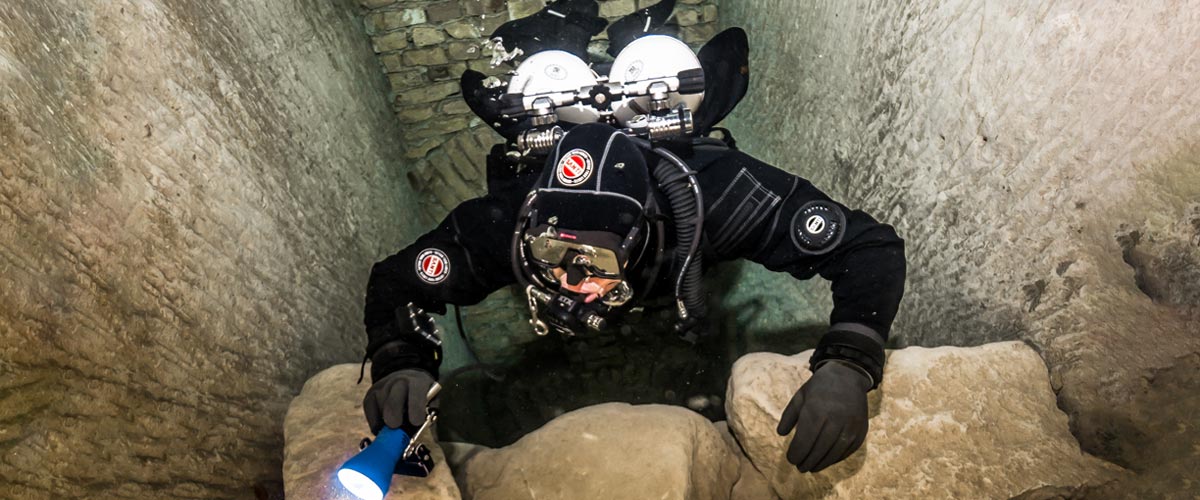
Article by José Pablo Mir
Pictures by Cezary Abramowski
The world of technical diving is exciting. It opens the door to new sites, depths, and bottom times. More importantly, it opens our minds to a new way of planning, facing, and experiencing dives, even those not purely technical.
Becoming a technical diver is a process, and like in other aspects of life, we should find the proper entry point that suits us best based on our knowledge and experience. The Introduction to Technical Diving course from TDI -the world’s largest and most recognized technical diving teaching organization- is the best option for divers who have yet to gain experience in the fundamental aspects of this new practice. The course’s content and its embrace of new techniques and technologies make it possible to acquire a solid foundation to learn and gain experience in this practice properly.
Becoming a technical diver is not something that happens overnight, whether deciding to become one or receiving a certification card stating we are now technical divers. It is a slow process extending farther away than any introductory course. It requires effort and dedication. But it will bring us satisfaction from day one -or two.
It is a matter of mentality
First, we must understand and accept that technical diving, involving greater depths, longer bottom times, exotic gases, virtual or real ceilings, and more, comes with higher levels of risk than the sport diving we have been practicing until now.
Although this discussion usually starts with a warning about risks, as I’ve done in the previous sentence, our practice is not a game of chance.
Technical diving is a rational activity that requires maturity and good judgment, and we will put everything into ensuring that each dive is a successful one -meaning we return from it safe and sound. With this understanding, we will strive to establish a mental attitude more aligned with our practice and its realities.
This new “technical diver” mindset we will develop will lead us to be more cautious in our executions, more analytical in our plans, more rational in our strategies, and more detailed in our procedures.
Experience will keep teaching us to know ourselves better, to keep our anxiety and other emotions under control, and to manage our impulses. Over time, our senses will sharpen, and we will be more attentive to the particulars of the situation we find ourselves in.
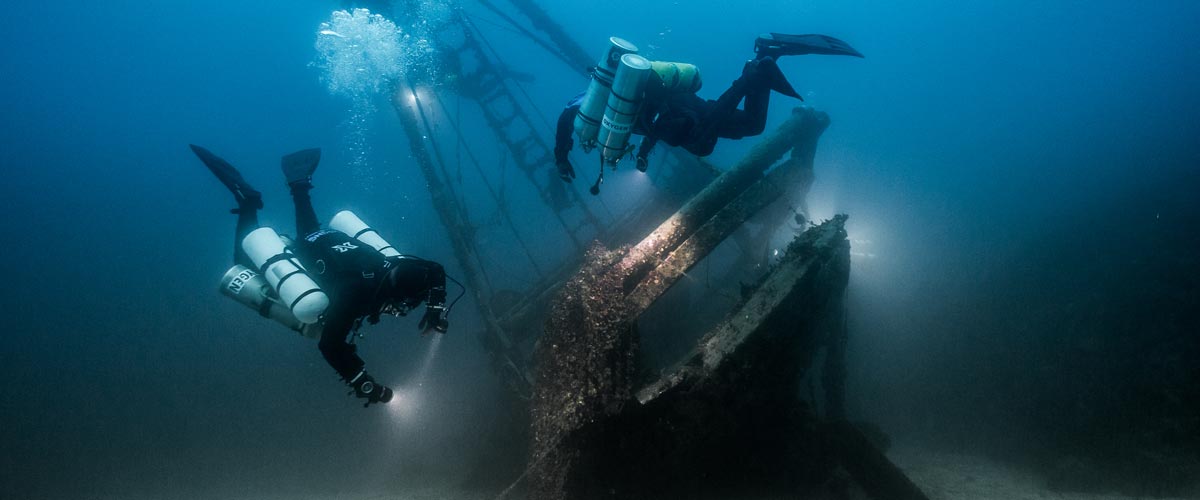
Strategies and procedures
Our strategies, those broad guiding lines tracing the path to follow, from how to approach planning to where, with what, and how we are willing to get there, will be more specific and more practical. Not because they magically become so, but because we will consciously and deliberately frame them that way.
We will establish clear, concise, and realistic procedures. Not only for the undesirable situations that may present themselves but also for those that are part of our dive objectives.
Even though, as technical divers, we often use equipment different from what we were previously accustomed to, it is essential to note that the gear does not make the diver. In a way, we could consider such equipment as the necessary tools to implement what our goal seeks to achieve, according to our strategies and procedures.
Technique plays an important role
We must put our greatest effort into learning and perfecting the different techniques we will be acquiring. Buoyancy, trim, propulsion, cylinder handling, deploying DSMBs and lift bags, valve drills, and more are essential skills we must begin to master to progress in our art. What we cannot do, when we need to do it, can harm us.
Our techniques must be effective and achieve the purpose for which they were devised. But they must also be efficient and require the least resources possible, including the time they take and the effort they demand. Effectiveness and efficiency will prevail over beauty and other considerations that may come to mind, although none of them should be mutually exclusive. A technique executed efficiently and effectively tends to have an inherent beauty.
Refining techniques is a lifelong mission. Some of them will be easy to master from the go; others, on the other hand, will be our life mission and will require many repetitions just to resemble the idea we have in mind of how they should be executed.
We must consider the environment
Our learning, the needs and musts of the practice we engage in, the experience we gradually gain, our strategies and procedures, and even our equipment and tools change with the environment.
Diving in the ocean, everything about us must be suitable for ocean dives. Conditions there rarely emulate those found in a pool, lake, or river. Variable winds and currents, greater depths, visibility conditions, other divers with uncertain skills around us, marine life, maritime traffic, distance from the coast, and many other factors add complexity and uncertainty.
It is never necessary to master the pool on the first day, but planning and aspiring to gradually cope with the ocean’s conditions is essential.
The cost of good training
We are aware that our resources are often scarce in relation to the possibilities of use we could give them if they were not. To a greater or lesser extent, we are part of the economic reality in which we are embedded.
Fortunately, the cost of good technical diver training is not an entry barrier. Comparing training and equipment costs, we see that the former are generally lower. Yes, lower cost for personalized service, essential to our future
performance and safety, than for a series of mass-produced products that are mere, albeit necessary, tools for an end.
The value of good training
The value of the training we received encompasses a range of characteristics, from emotional and methodological to technical and technological. TDI and its Introduction to Technical Diving course offer a deep and modern approach, with a teaching strategy that aims to create thinking divers, not merely obedient ones.
As technical divers, our knowledge is our primary tool. In this type of activity, what we don’t know can harm us.
Is this course optional?
Unfortunately, the fact that this Introduction to Technical Diving course is not a prerequisite for any subsequent training is an invitation to consider it optional. And we all know what usually happens to “optional” under budget constraints.
However, this course should be seen as optional only by those divers who are somehow familiar with the use of technical equipment, who have a mindset more in line with the requirements of this type of diving, who plan and execute the dives the proper “technical” way, who know their gas consumption rate, who are not intimidated by non-decompression tables, who feel comfortable using their dive computers, and know the techniques and have at least an acceptable level of buoyancy, positioning, and propulsion. Those can go straight to a more advanced training course, such as TDI’s Advanced Nitrox.
We must ask ourselves whether or not we are in that group.
Remember our goal: to have fun
Recreational diving is our passion. Jumping into the water carrying heavy equipment and having properly dotted our I’s and crossed our T’s have only one ultimate goal: fun. This is the activity we have chosen as a hobby. We must enjoy it; it must give us pleasure and make us vibrate.
Having a good time is not optional!
Blogs
Four opportunities to go pro in 2024 with Dive Friends Bonaire
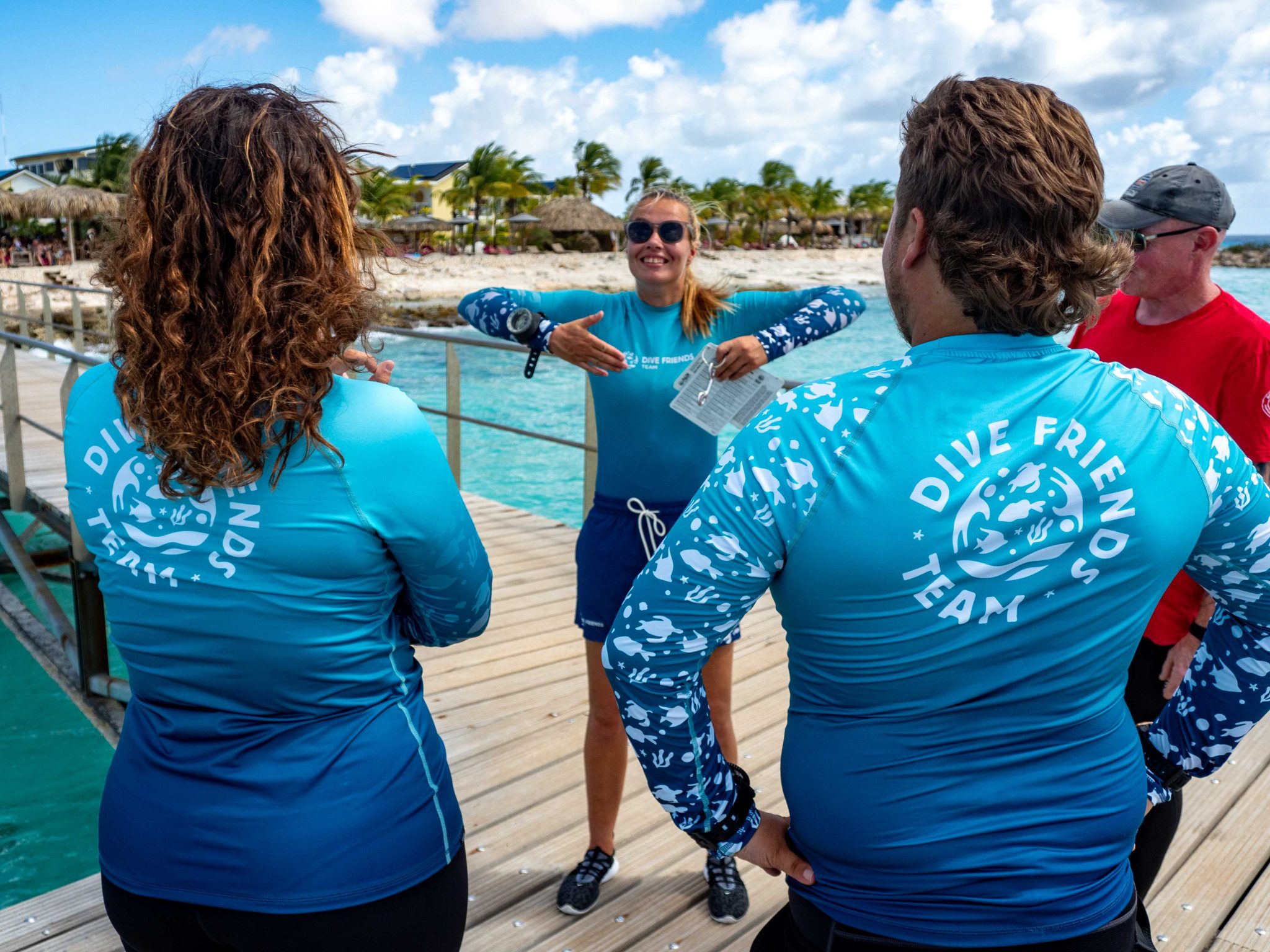
Dive Friends teaches the Instructor Development Course (IDC) several times a year to students who are eager to share their passion for diving with the world.
Dive Friends is known for the personal approach throughout the course. Their in-house course director will lead the students through every essential step, mentoring them to achieve their fullest potential as a dive instructor.
Applications for the following IDC start dates are now open:
- 12 April
- 5 July,
- 20 September
- 29 November
Partnership with Casita Palma
If the student opts for the IDC-Deluxe or IDC-Supreme package, their accommodation will be arranged for them at Casita Palma. This small and quiet resort is within walking distance from Dive Friends Bonaire’s main dive shop location and has everything you need to relax after an intense day of IDC training. Breakfast is included, so the student will always be fuelled and ready for their day.
Contact Dive Friends Bonaire’s Course Director Eddy for more information: coursedirector@divefriendsbonaire.com.
-

 News3 months ago
News3 months agoHone your underwater photography skills with Alphamarine Photography at Red Sea Diving Safari in March
-

 News2 months ago
News2 months agoCapturing Critters in Lembeh Underwater Photography Workshop 2024: Event Roundup
-

 Marine Life & Conservation Blogs2 months ago
Marine Life & Conservation Blogs2 months agoCreature Feature: Swell Sharks
-

 Blogs2 months ago
Blogs2 months agoMurex Resorts: Passport to Paradise!
-

 Blogs2 months ago
Blogs2 months agoDiver Discovering Whale Skeletons Beneath Ice Judged World’s Best Underwater Photograph
-

 Gear News3 months ago
Gear News3 months agoBare X-Mission Drysuit: Ideal for Both Technical and Recreational Divers
-

 Gear Reviews2 months ago
Gear Reviews2 months agoGear Review: Oceanic+ Dive Housing for iPhone
-

 Marine Life & Conservation2 months ago
Marine Life & Conservation2 months agoSave the Manatee Club launches brand new webcams at Silver Springs State Park, Florida


